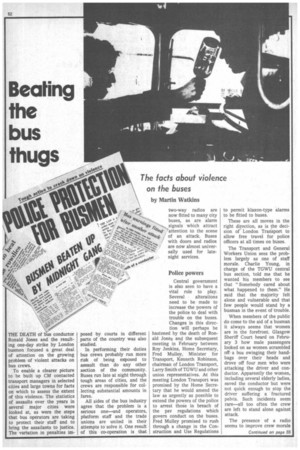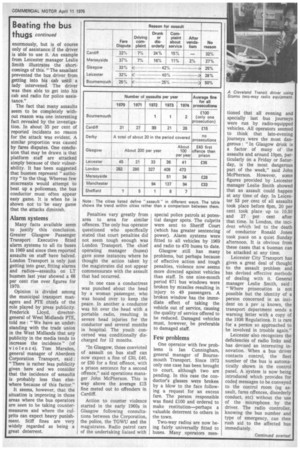Beating the bus thugs
Page 54

Page 57

Page 58

If you've noticed an error in this article please click here to report it so we can fix it.
The facts about violence on the buses
by Martin Watkins
THE DEATH of bus conductor Ronald Jones and the resulting one-day strike by London busmen focused a great deal of attention on the growing problem of violent attacks on bus crews.
To enable a clearer picture to be built up CM contacted transport managers in selected cities and large towns for facts on which to assess the extent of this violence. The statistics of assaults over the years in several major cities were looked at, as were the steps that bus operators are taking to protect their staff and to bring the assailants to justice. The variation in penalties im posed by courts in different parts of the country was also studied.
In performing their duties bus crews probably run more risk of being exposed to assault than do any other section of the community. Buses run late at night through tough areas of cities, and the crews are responsible for collecting substantial amounts in fares.
All sides of the bus industry agree that the problem is a serious one—and operators, platform staff and the trade unions are united in their attempts to solve it. One result of this co-operation is that two-way radios are now fitted to many city buses, as are alarm signals which attract 'attention to the scene of an attack. Buses with doors and radios are now almost universally used for latenight services.
Police powers
Central government is also seen to have a vital role to play.
Several alterations need to be made to increase the powers of the police to deal with trouble on the buses. Changes in this direction will perhaps be hastened by the death of Ronald Jones and the subsequent meeting in February between Roy Jenkins, Home Secretary, Fred Mulley, Minister for Transport, Kenneth Robinson, chairman of London Transport, Larry Smith of TGWU and other union representatives. At this meeting London Transport was promised by the Home Secretary that he would amend the law as urgently as possible to extend the powers of the police to arrest those in breach of the psv regulations which govern conduct on the buses. Fred Mulley promised to rush through a change in the Construction and Use Regulations to permit klaxon-type alarms to be fitted to buses.
These are all moves in the right direction, as is the decision or London Transport to allow free travel for police officers at all times on buses.
The Transport and General Workers Union sees the problem largely as one of staff morale. Charlie Young, in charge of the TGWU central bus section, told me that he wanted his members to see that "Somebody cared about what happened to them." He said that the majority felt alone and vulnerable and that few people would stand by a busman in the event of trouble.
When members of the public do come to the aid of a busman it always seems that women are in the forefront. Glasgow Sheriff Court heard on February 3 how male passengers looked on as women scrambled off a bus swinging their handbags over their heads and drove off four men who were attacking the driver and conductor. Apparently the women, including several elderly ladies, saved the conductor but were not quick enough to stop the driver suffering a fractured pelvis. Such incidents seem rare—all too often the crew are left to stand alone against attack.
The presence of a radio seems to improve crew morale enormously, but is of course only of assistance if the driver is able to use it. An example from Leicester manager Leslie Smith illustrates the shortcomings of this. "The assailant prevented the bus driver from getting into his cab until a lady intervened. The driver was then able to get into his cab and radio for police assistance."
The fact that many assaults seem to be completely without reason was one interesting fact revealed by the investigation. In about 35 per cent of reported incidents no reason for the attack was evident. A similar proportion was caused by fares disputes. One conclusion that may be drawn is that platform staff are attacked simply because of their vulnerability. It has been suggested that busmen represent "authority " to the thug. Whereas few miscreants would attempt to beat up a policeman, the bus conductor must often appear easy game. It is when he is shown not to be easy game that the attacks diminish.
Alarm systems
Many facts available seem to justify this conclusion. Greater Glasgow Passenger Transport Executive fitted alarm systems to all its buses in 1969 and since then reported assaults on staff have halved. London Transport is only just getting into gear, fitting alarms and radios—assaults on LT busmen last year showed a 66 per cent rise over figures for 1970.
Opinion is divided among the municipal transport managers and PTE chiefs of the role played by press publicity. Frederick Lloyd, directorgeneral of West Midlands PTE, told me : "We have an understanding with the trade union in the West Midlands that any publicity in the media tends to increase the incidence" (of violence). Tom Marsden, general manager of Aberdeen Corporation Transport, said : "There is rather less publicity given here and we consider that the incidence of assaults is probably less than elsewhere because of this factor."
It seems, however, that the situation is improving in those areas where the bus operators are seen to be taking countermeasures and where the culprits can expect heavy punishment. Stiff fines are very widely regarded as being a great deterrent. Penalties vary greatly from area to area for similar offences. The only bus operator questioned who specifically stated that court penalties did not seem tough enough was London Transport. The chief operating manager (buses) gave some instances where he thought the action taken by the magistrates did not appear commensurate with the assault that had occurred.
In one case a conductress was punched about the head by a woman passenger, who was bound over to keep the peace. In another a conductor was hit over the head with a portable radio, resulting in severe head injuries for the conductor 'and several months in hospital. The youth concerned was conditionally discharged for 12 months.
"In Glasgow, those convicted of assault on bus staff can now expect a fine of £30, £40, or £50 for a first offence, with a prison sentence for a second offence," said operations manager John McPherson. This is way above the average £15 fine meted out to offenders in Cardiff.
Action to counter violence started in the early 1960s in Glasgow following consultations between the Corporation, the police, the TGWU and the magistrates. Radio patrol cars of the undertaking liaised with special police patrols at potential danger spots. The culprits were sent to Sheriff Court (which has greater sentencing power). Alarm systems were fitted to all vehicles by 1969 and radio to 470 buses to date.
Glasgow still has many problems, but perhaps because of effective action and tough penalties, violence now seems more directed against vehicles than staff. In one nine-month period 671 bus windows were broken by missiles resulting in injury to 49 passengers. A broken window has the immediate effect of taking the vehicle out of service, causing the quality of service offered to be reduced. Damaged vehicles must, however, be preferable to damaged staff.
Few problems
One operator with few problems is Ian Cunningham, general manager of Bournemouth Transport. Since 1972 only one case has been brought to court, although two are pending. In this case the conductor's glasses were broken by a blow to the face following a request for an excess fare. The person responsible was fined £100 and ordered to make restitution—perhaps a valuable deterrent to others in the town.
Two-way radios are now being fairly universally fitted to buses. Many operators men tioned that all evening and specially last bus journeys were run by radio-equipped vehicles. All operators seemed to think that late-evening journeys were the most dangerous: "In Glasgow drink is a factor of many of the assaults and around lOpm, particularly on a Friday or Saturday, is the most dangerous part of the week," said John McPherson. However, some figures provided by Leicester manager Leslie Smith showed that an assault could happen at any time of day. In Leicester 53 per cent of all assaults took place before 6pm, 20 per cent took place up to 10.30 and 27 per cent after that time. In London, the incident which led to the death of conductor Ronald Jones took piace on a quiet Sunday afternoon. It is obvious from these cases that a busman can be attacked at any time.
Leicester City Transport has given a great deal of thought to the assault problem and has devised effective methods of dealing with it. General manager Leslie Smith, said : "Where prosecution is not possible but the identity of a person concerned in an incident on a psv is known, the transport department sends a warning letter with a copy of the 1936 Regulations. It is rare for a person so approached to be involved in trouble again."
Leicester also recognizes the deficiencies of radio links and has devised an interesting innovation. When a bus driver contacts control, the fleet number of the bus is automatically shown in the control panel. A system is now being introduced which provides for coded messages to be conveyed to the control room (eg assault, fares offences, disorderly conduct, etc) without the use of the microphone by the driver. The radio controller, knowing the bus number and type of emergency, can then rush aid to the affected bus immediately. This system can really be used only in a city like Lei cester where there are many short radial routes. In other situations locating the bus in distress would be a major problem.
Police co-operation was praised by every operator. South Yorks PTE spokesman Alan Marshall told CM: "Police co-operation is excellent, plain-clothes officers in certain instances travel on vehicles and also a patrol car follows buses that assaults have been known to take place on."
London Transport has an enormous problem of violence but seems to be only now taking effective steps to deal with the situation — some 15 years after Glasgow formulated its plans.
LT spokesman Kenneth Pope said : "A crash pro gramme is currently taking place to fit some 5,000 buses with a special anti-hooligan device. This is a box fitted in the driver's cab that at the touch of a button sets off the alarm—intermittent flashing of all four traffic indicators with the horn sounding between the flashes. Some 100 buses have already been fitted at North Kensington and Cricklewood garages, and we are hoping to complete the task for the whole fleet by the end of the year."
Short-wave radios were being fitted to some buses and more would be in the future.
London Transport also intends to oppose the renewal of licences of pubs and clubs that are known trouble spots.
One idea initiated by LT last year was the holding of semi nars for busmen to pool their ideas and experience on the best way of dealing with, and avoiding, incidents on buses.
An unfortunate fact is that conscientious staff are more subject to attack than their less effective colleagues. The conductor who challenges non payers or overriders is much more at risk than one who keeps a low profile and turns a blind eye.
An encouraging conclusion to this investigation is that in most instances the incidence of violent attacks on busmen is a static or declining occurrence.
Hopefully, the measures currently being undertaken by London Transport will soon turn the tide in the capital as they have in the provinces.




































































































































